
Affondatore was an armoured ram of the Regia Marina, built in the 1860s by Harrison, Millwall, London. Construction commenced in 1863; the ship, despite being incomplete, was brought to Italy during the Third Italian War of Independence. Affondatore, which translates as "Sinker", was initially designed to rely on her ram as her only weapon, but during construction she was also equipped with two 300-pounder guns.
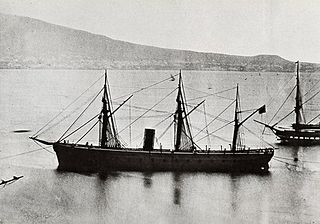
Re d'Italia was the lead ship of the Re d'Italia-class armored frigates built in the United States for the Italian Regia Marina in the early 1860s. She was laid down at the William H. Webb Shipyard in New York in November 1861, was launched in April 1863, and was completed a year later in September 1864; the two Re d'Italia-class ships were the only Italian ironclads built in the United States. The ships were broadside ironclads, armed with a battery of six 72-pounder guns and thirty-two 164 mm (6.5 in) guns.

SMS Kaiser was a 92-gun wooden ship of the line of the Austrian Navy, the last vessel of the type, and the only screw-driven example, to be built by the Austrians. She was built by the naval shipyard in Pola; she was laid down in March 1855, was launched in October 1858, and was completed the following year. The ship took part in the Second Schleswig War of 1864, but saw no action during her deployment to the North Sea. Kaiser did see action during the Seven Weeks' War two years later, during which she took part in the Battle of Lissa as the flagship of Anton von Petz, commander of the Austrian 2nd Division. Kaiser engaged several Italian ironclads simultaneously, rammed one—Re di Portogallo—and damaged another—Affondatore—with gunfire. In doing so, she became the only wooden ship of the line to engage an ironclad warship in battle.

The Principe Amedeo class was a pair of ironclad warships built for the Italian Regia Marina in the 1870s and 1880s. They were the culmination of a major naval construction program designed to give Italy a powerful fleet of ironclads. The two ships, Principe Amedeo and Palestro, were the last Italian ironclads to feature sailing rigs and wooden hulls. They were armed with a battery of six 254 mm (10 in) guns and were capable of a speed in excess of 12 knots. The ships had uneventful careers, spending much of it in Italy's colonial empire. By the late 1880s, they were withdrawn from service and employed in secondary roles, first as headquarters ships for harbor defenses. Principe Amedeo was converted into a depot ship in 1895 and was discarded in 1910, while Palestro was used as a training ship from 1894 to 1900 before being scrapped between 1902 and 1904.
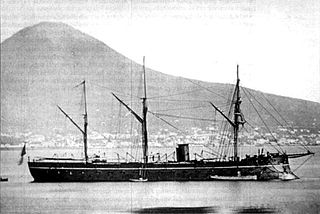
Regina Maria Pia was the lead ship of the Regina Maria Pia class of ironclad warships built in French shipyards for the Italian Regia Marina in the 1860s. She and her three sister ships were broadside ironclads, mounting a battery of four 203 mm (8 in) and twenty-two 164 mm (6.5 in) guns on the broadside. Regina Maria Pia was laid down in July 1862, was launched in April 1863, and was completed in April 1864.

San Martino was a Regina Maria Pia-class ironclad warship, the second member of her class. She was built for the Italian Regia Marina in the 1860s; like her three sister ships, she was built in France. San Martino was laid down in July 1862, was launched in September 1863, and was completed in November 1864. The ships were broadside ironclads, mounting a battery of four 203 mm (8 in) and twenty-two 164 mm (6.5 in) guns on the broadside.

Castelfidardo was the third of four Regina Maria Pia-class ironclad warships built in French shipyards for the Italian Regia Marina in the 1860s. Castelfidardo was laid down in July 1862, was launched in August 1863, and was completed in May 1864. She and her three sister ships were broadside ironclads, mounting a battery of four 203 mm (8 in) and twenty-two 164 mm (6.5 in) guns on the broadside.
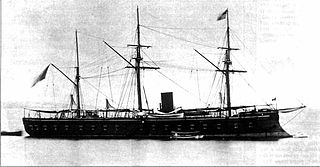
Ancona was an ironclad warship, the last member of the Regina Maria Pia class built in French shipyards for the Italian Regia Marina in the 1860s. Ancona was laid down in August 1862, was launched in October 1864, and completed in April 1866. She and her three sister ships were broadside ironclads, mounting a battery of four 203 mm (8 in) and twenty-two 164 mm (6.5 in) guns on the broadside.

Re di Portogallo was an ironclad warship built for the Italian Regia Marina in the 1860s, the second and final member of the Re d'Italia class. She was laid down at the William H. Webb Shipyard in New York in December 1861, was launched in August 1863, and was completed a year later in August 1864; the two Re d'Italia-class ships were the only Italian ironclads built in the United States. The ships were broadside ironclads, armed with a battery of six 72-pounder guns and thirty-two 164 mm (6.5 in) guns.
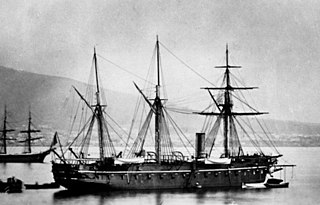
Principe di Carignano was the lead ship of the Principe di Carignano class of ironclad warships built for the Italian Regia Marina in the 1860s. She was the first ironclad built in Italy; her keel was laid January 1861, her hull was launched in September 1863, and she was completed in June 1865. Principe di Carignano was a broadside ironclad armed with a battery of ten 203 mm (8 in) guns and twelve 164 mm (6.5 in) guns.

Messina was the second of three Principe di Carignano-class ironclads built for the Italian Regia Marina in the 1860s. She was laid down in September 1861, her hull was launched in December 1864, and she was completed in February 1867. Messina was a broadside ironclad armed with a battery of four 203 mm (8 in) guns and eighteen 164 mm (6.5 in) guns. Her career was limited, owing to the emergence of more modern ironclads and a severe reduction in the Italian naval budget following their defeat at the Battle of Lissa in 1866. She was discarded in 1875 and sold to ship breakers to help pay for new ironclads then under construction.

Conte Verde was the third of three Principe di Carignano-class ironclads built for the Italian Regia Marina, though she differed in several respects from her sisters. Unlike the other two members of her class, she did not receive complete iron armor, instead relying on partial plating at her bow and stern. She was laid down in February 1863, she was launched in July 1867, and she was completed in December 1871. Conte Verde was a broadside ironclad armed with a battery of four 203 mm (8 in) guns and eighteen 164 mm (6.5 in) guns. Her career was limited, owing to the emergence of more modern ironclads and a severe reduction in the Italian naval budget following their defeat at the Battle of Lissa in 1866. She was discarded in 1880 and sold to ship breakers to help pay for new ironclads then under construction.

Terribile was the first ironclad warship to be built for the Italian Regia Marina, and the second member of the Formidabile class. Terribile and her sister, Formidabile, were both built in France. A broadside ironclad, she was laid down in June 1860, launched in February 1861, and was completed in September that year. She was the first Italian ironclad to enter service and was equipped with four 203 mm (8 in) and sixteen 164 mm (6.5 in) guns.
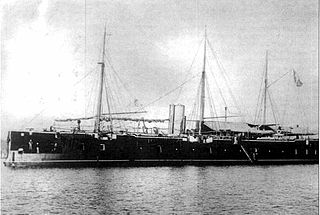
Formidabile was the lead ship of the Formidabile-class ironclad warships, the first ships of that type to be built for the newly formed Italian Regia Marina. Formidabile and her sister, Terribile, were both built in France; Formidabile was laid down in December 1860, was launched in October 1861, and was completed in May 1862. She was a broadside ironclad, equipped with four 203 mm (8 in) and sixteen 164 mm (6.5 in) guns.

The Regina Maria Pia class was a group of four ironclad warships built for the Italian Regia Marina in the 1860s. The class comprised four ships, Regina Maria Pia, San Martino, Castelfidardo, and Ancona. They were built by French shipyards, since Italian yards were unable to meet the demand of the rapidly expanding Italian fleet. The ships were broadside ironclads and mounted a battery of twenty-six muzzle loading guns.

The Principe di Carignano class was a group of three ironclad warships built for the Italian Regia Marina in the 1860s. The class comprised the ships Principe di Carignano, Messina, and Conte Verde. Originally ordered as wooden frigates, they were the first ironclads to be built in Italy, but the inexperience of the Italian shipyards and the redesign process produced lengthy construction times, such that only the lead ship was completed in time to see action during the Third Italian War of Independence in 1866. The first two ships were protected by a complete belt of wrought iron plating that was 121 mm (4.75 in) thick, while Conte Verde only received a partial iron belt.

The Formidabile class was a pair of ironclad warships built for the Italian Regia Marina in the 1860s. The class comprised two ships, Formidabile and Terribile. Initially ordered for the Regia Marina Sarda, by the time they were completed the Kingdom of Sardinia had unified the rest of the Italian states and created the Regia Marina. They were the first ironclads built for the Italian fleet. Wooden-hulled vessels plated with 4.3 inches (109 mm) of wrought iron, they were armed with a battery of twenty guns in a broadside arrangement.
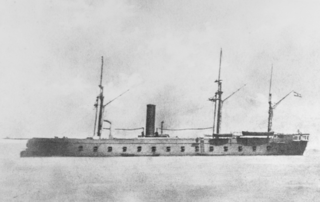
SMS Kaiser Max was the lead ship of the Kaiser Max class of armored frigates built for the Austrian Navy in the 1860s. Her keel was laid in October 1861 at the Stabilimento Tecnico Triestino shipyard; she was launched in May 1862, and was completed in 1863. She carried her main battery—composed of sixteen 48-pounder guns and fifteen 24-pounders—in a traditional broadside arrangement, protected by an armored belt that was 110 mm (4.3 in) thick.

A naval arms race between the Austrian Empire and Italy began in the 1860s when both ordered a series of ironclad warships, steam-propelled vessels protected by iron or steel armor plates and far more powerful than all-wood ships of the line. These ships were constructed to establish control over the Adriatic Sea in the event of a conflict between the two countries.














